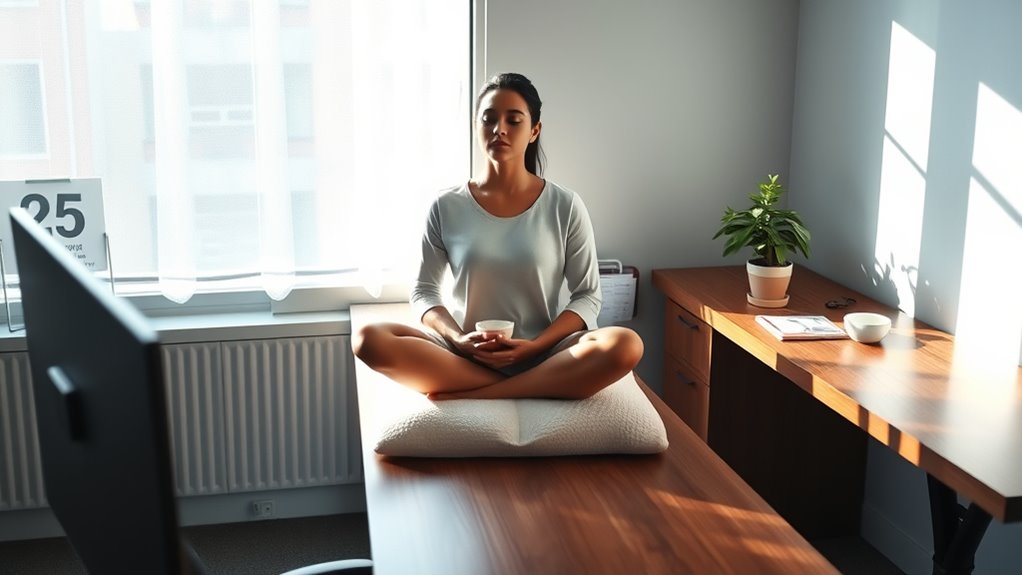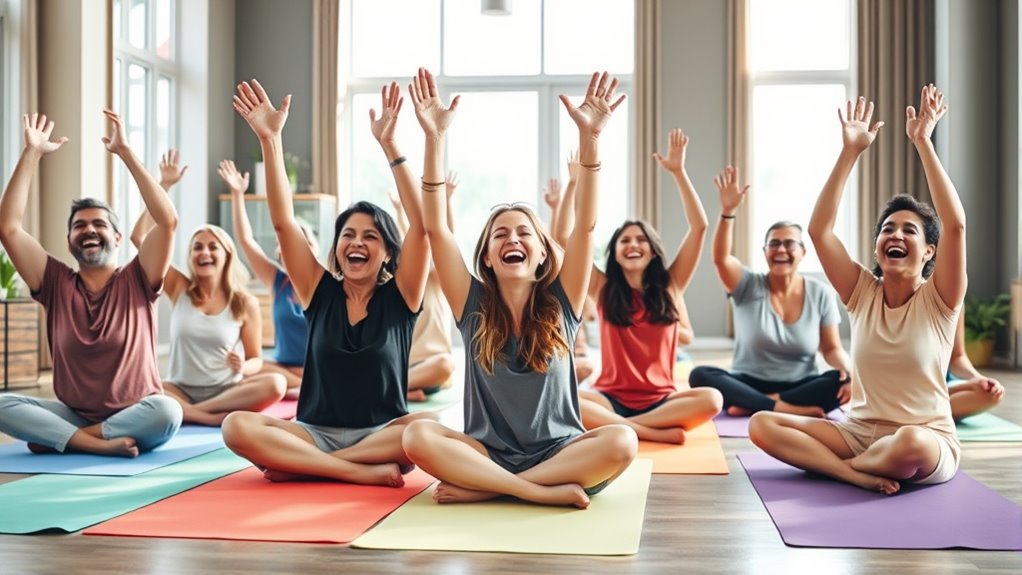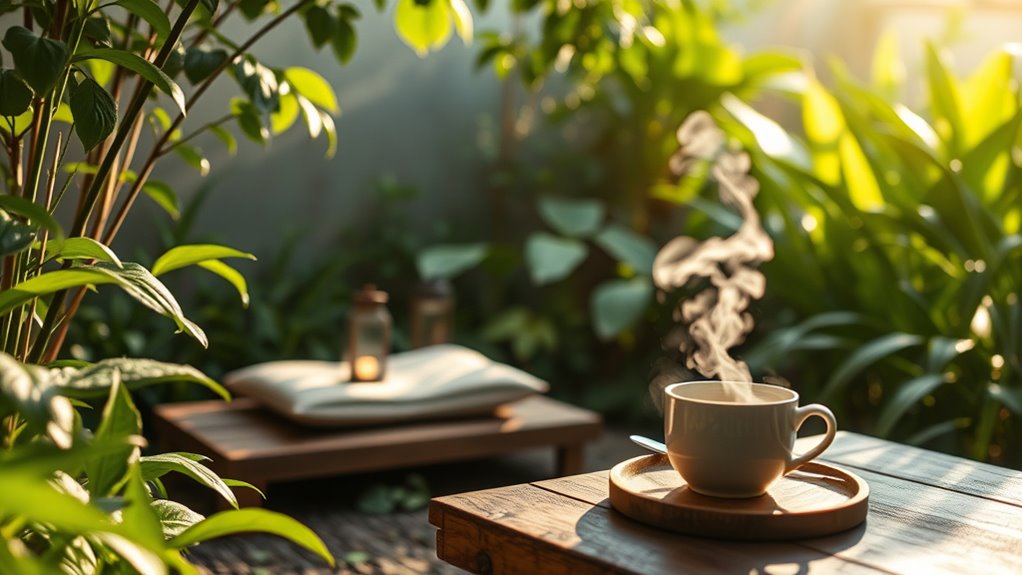Mindfulness & Well‑Being
Office Mindfulness: Quiet Practices You Can Do at Your Desk
Mindfulness at your desk can transform stress into calm, but discovering the quiet practices that work best for you can unlock lasting focus and peace.

To boost focus and reduce stress at your desk, try simple mindfulness practices like breathing exercises and brief meditation pauses. Sit comfortably, take slow deep breaths through your nose, hold briefly, then exhale gently. Focus on your breath or bodily sensations, noting thoughts without judgment. Even a few minutes of this can clear your mind and promote calm throughout your day. Exploring more techniques can help you create a peaceful, productive workspace—discover how further inside.
Key Takeaways
- Practice quick breathing exercises, like deep inhales and gentle exhales, to reduce stress and improve focus at your desk.
- Incorporate brief desk meditation sessions by observing breath or bodily sensations without judgment.
- Use visualization techniques during exhalation to release tension and promote calmness throughout your workday.
- Maintain a regular routine of short mindfulness practices to enhance mental clarity and emotional resilience.
- Focus on consistency; even brief, quiet pauses can break stress cycles and boost overall well-being during office hours.

Have you ever wondered how a moment of calm can transform your busy workday? In the midst of deadlines and meetings, taking a brief pause can make all the difference. One simple way to introduce calm into your routine is through breathing exercises. These can be done right at your desk and require nothing more than a few focused breaths. Just sit comfortably, close your eyes if you like, and take a slow, deep inhale through your nose. Hold it for a count of three, then exhale gently through your mouth. Repeat this for a few cycles, paying close attention to the sensation of your breath. This practice helps reduce stress hormones, clears your mind, and improves your focus. Breathing exercises are quick, portable, and effective, making them perfect for busy professionals.
Another effective quiet practice you can incorporate is desk meditation. Unlike traditional meditation, which might seem time-consuming or requiring special space, desk meditation involves a brief, mindful pause at your workspace. To start, sit upright with your feet flat on the ground and your hands resting comfortably. Close your eyes or soften your gaze, and bring your attention to your breath or the sensations in your body. Focus on the present moment, observing thoughts or distractions without judgment. If your mind wanders, gently redirect it back to your breath or bodily sensations. Even just a minute or two of desk meditation can help break the cycle of stress and mental clutter that often accumulates during the day.
You can also combine breathing exercises with desk meditation for a more integrated approach. For example, take a deep breath, hold it briefly, then exhale slowly while visualizing releasing tension. Repeat this cycle a few times, consciously relaxing your muscles as you breathe out. This combination enhances your awareness, centers your thoughts, and fosters a sense of calm amid your busy schedule. The key is consistency, as even short, daily sessions can markedly boost your mental clarity and emotional resilience over time.
Frequently Asked Questions
Can Mindfulness Improve Productivity at Work?
Mindfulness benefits your work focus by helping you stay present and reduce distractions. When you practice mindfulness, you become more aware of your thoughts and emotions, allowing you to manage stress better. This clarity boosts your productivity, enabling you to complete tasks efficiently. Incorporating simple mindful habits into your day can transform your work routine, making you more focused, calm, and effective in achieving your professional goals.
How Long Should Office Mindfulness Sessions Last?
Research shows that even brief mindfulness sessions can boost focus and reduce stress. When considering mindfulness duration, aim for sessions of 5 to 10 minutes; this is often enough to reap benefits without disrupting your workflow. Keep session length manageable, and gradually extend it if you find it helpful. Short, consistent mindfulness practices fit well into a busy workday and enhance overall well-being.
Are There Apps to Guide Desk Mindfulness Exercises?
Yes, there are apps that guide desk mindfulness exercises. You can find apps offering guided meditation and breathing exercises, perfect for quick stress relief. These apps help you stay focused and calm during busy workdays, making it easier to integrate mindfulness into your routine. Try apps like Headspace, Calm, or Insight Timer—they provide step-by-step guidance for effective breathing exercises and meditation sessions right at your desk.
Is Mindfulness Suitable for High-Stress Work Environments?
You might wonder if mindfulness suits high-stress workplaces. Many believe mindfulness is just about relaxing, but misconceptions exist. It actually helps reduce workplace stress by increasing focus and emotional resilience. You can practice simple techniques at your desk, making it practical for busy environments. So, yes, mindfulness is suitable—it can improve your well-being and productivity, even in high-pressure settings. Just start with small, consistent steps to see its benefits.
Can Mindfulness Help Reduce Workplace Conflicts?
Mindfulness can definitely help reduce workplace conflicts by improving interpersonal harmony. When you practice mindfulness, you become more aware of your emotions and reactions, which aids in conflict resolution. This awareness helps you respond calmly and thoughtfully rather than impulsively. As a result, you foster a more collaborative environment, resolve misunderstandings more effectively, and create a more harmonious workplace where conflicts are minimized and relationships are strengthened.
Conclusion
By practicing these simple mindfulness techniques at your desk, you’ll transform your workspace into a sanctuary of calm amidst chaos. Imagine turning your cluttered desk into a peaceful oasis, where stress melts away like ice cream in the sun. With just a few quiet moments, you’ll feel more centered than a mountain peak and more focused than a laser beam. Embrace these practices, and watch your workday become a serene, unstoppable wave of clarity and calm.
Mindfulness & Well‑Being
Gratitude Practices: How Journaling Shapes Happiness
Absolutely, exploring gratitude journaling can unlock lasting happiness and contentment by rewiring your mindset for positivity.

Journaling your gratitude helps shift your focus from what’s missing to what you already have, fostering greater happiness and contentment. By regularly writing about positive experiences, you rewire your brain to notice and appreciate more blessings in your daily life. Pairing this with mindfulness and positive affirmations deepens the impact, making gratitude a natural part of your mindset. Keep exploring, and you’ll discover how these practices can transform your overall well-being.
Key Takeaways
- Journaling shifts focus from lack to abundance, fostering contentment and increased happiness.
- It creates a tangible record of growth, reinforcing positive self-image and gratitude over time.
- Combining journaling with mindfulness enhances awareness of small blessings, deepening feelings of thankfulness.
- Regular gratitude journaling rewires the brain to prioritize positive aspects, reducing negativity and stress.
- Consistent practice builds resilience, optimism, and long-term well-being by integrating gratitude into daily life.

Have you ever wondered how practicing gratitude can transform your outlook on life? One of the most effective ways to cultivate a grateful mindset is through journaling, which allows you to reflect on the positive aspects of your life daily. When you take time to write about what you’re thankful for, it shifts your focus from what’s lacking to what you already have, fostering a sense of contentment and joy. Incorporating mindfulness meditation into your routine enhances this process by helping you stay present and aware of your feelings, making your gratitude journaling more meaningful. As you meditate, you become more attuned to the small, often overlooked blessings around you, which you can then capture in your journal. This practice trains your mind to notice positivity, making gratitude a natural response rather than a fleeting emotion. Additionally, optimizing your journaling environment with well-structured content can improve your engagement and consistency.
Using positive affirmations alongside journaling can amplify the benefits of your gratitude practice. When you write affirmations like “I am grateful for my health” or “I appreciate the love in my life,” you’re reinforcing a positive self-image and encouraging a mindset of abundance. These affirmations can be tailored to your specific circumstances, making your gratitude practice more personalized and impactful. Over time, your repeated positive statements help rewire your brain to focus on what’s good, reducing tendencies toward negativity and stress.
Journaling also provides a physical record of your growth, allowing you to look back and see how your attitude has shifted over weeks or months. This tangible evidence of progress boosts your motivation to continue practicing gratitude, especially during challenging times. When combined with mindfulness meditation, your journaling becomes a more profound experience. Meditation calms your mind, making it easier to access genuine feelings of thankfulness, while journaling helps solidify those feelings through writing. Together, these practices create a powerful cycle of awareness and appreciation that enhances your overall happiness.
Furthermore, dedicating a few minutes each day to this combined practice encourages consistency, which is key to reaping long-term benefits. As you develop this habit, you’ll notice a more optimistic outlook, improved resilience, and a deeper connection to your inner self. The act of journaling, supported by mindfulness meditation and positive affirmations, becomes a daily ritual that rewires your mindset, making gratitude an integral part of your life. With dedication, you’ll find that these small, intentional acts can considerably elevate your sense of well-being and happiness, helping you navigate life’s ups and downs with greater ease.
Frequently Asked Questions
Can Gratitude Journaling Improve Mental Health Long-Term?
Yes, gratitude journaling can improve your long-term mental health. By regularly practicing gratitude, you boost mindfulness meditation, helping you stay present and reduce stress. This habit also strengthens emotional resilience, making it easier to handle life’s challenges. Over time, journaling fosters a positive outlook, decreases anxiety, and enhances overall well-being, creating a lasting impact on your mental health.
How Often Should I Journal for Maximum Benefits?
Think of your journaling routine as tending a garden; too little watering, and the plants wither; too much, and they drown. For ideal routine, aim to journal daily or every other day to nurture gratitude and happiness. Consistency matters more than length, so find a frequency that fits your lifestyle. Regular journaling helps solidify positive thoughts, creating lasting mental health benefits.
Are There Specific Prompts That Enhance Gratitude Practice?
Yes, using specific gratitude prompts can enhance your journaling techniques. Try prompts like “What made me smile today?” or “Who am I grateful for?” to deepen your reflection. These prompts guide you to focus on positive aspects, strengthening your gratitude practice. Incorporate variety and honesty, and make journaling a consistent habit. This approach helps you fully experience gratitude, boosting happiness and overall well-being.
Can Gratitude Journaling Help With Relationships?
Research suggests gratitude journaling can indeed strengthen relationships by fostering emotional connection and appreciation. When you regularly reflect on what you value in others, you actively nurture positive feelings, making it easier to build trust and deepen bonds. This practice promotes relationship strengthening as you become more aware of your partner’s qualities, encouraging kindness and empathy. Consistently journaling gratitude helps you nurture a healthier, more connected relationship over time.
What Are Common Challenges When Starting Gratitude Journaling?
When you start gratitude journaling, you might face initial resistance because it feels unfamiliar or awkward. Inconsistency can also be a challenge, making it hard to develop the habit. You may struggle to find things to be grateful for or forget to journal daily. To overcome these, set small, achievable goals, create a routine, and be patient with yourself. With time, gratitude journaling becomes a rewarding part of your day.
Conclusion
By incorporating gratitude journaling into your daily routine, you’ll find yourself more connected to the positive moments in life. It’s like planting seeds of happiness that grow over time, transforming your outlook and boosting your well-being. Remember, small acts of gratitude can lead to big changes, making your journey toward happiness feel as rewarding as watching a sunrise. Keep writing, stay grateful, and watch your happiness blossom like a beautiful garden.
Mindfulness & Well‑Being
Laughter Yoga: The Science of Joyful Exercise
Jumpstart your well-being with laughter yoga, where joyful exercise meets science—discover why this fun practice might just change your life.

Laughter yoga blends intentional laughter with breathing exercises to boost your physical and mental health. By engaging in this joyful practice, you activate feel-good chemicals like endorphins, reduce stress hormones, and improve your immune function. The physical act of laughing mimics moderate exercise, promoting relaxation, oxygen flow, and emotional release. As you continue exploring, you’ll discover how incorporating laughter yoga can transform your approach to stress and wellness.
Key Takeaways
- Laughter yoga combines intentional laughter with breathing exercises to promote physical and mental health benefits.
- It activates endorphin release, reducing stress hormones and boosting mood naturally.
- The practice enhances the mind-body connection, fostering relaxation and resilience against stress.
- Laughter increases oxygen flow and relaxes muscles, supporting overall physical well-being.
- Regular laughter yoga sessions can improve immune function and promote emotional balance.

Have you ever wondered how laughter can boost your well-being? It might seem simple, but laughter is a powerful tool that taps into your mind-body connection and promotes stress relief. When you laugh, you’re not just engaging your muscles; you’re activating a complex network that influences your mental and physical health. Laughter yoga combines intentional laughter with breathing exercises, creating a unique form of joyful exercise that leaves you feeling refreshed and energized. This practice isn’t about humor or comedy—it’s about generating genuine laughter without relying on jokes or funny stories, which makes it accessible to everyone. As you participate, you start to notice how your mood lifts and your body responds positively.
The mind-body connection plays an essential role in how laughter influences your overall well-being. When you laugh, your brain releases feel-good chemicals like endorphins, which enhance your mood and reduce pain perception. Simultaneously, laughter triggers a relaxation response, calming your nervous system and easing tension. This interaction between mind and body helps you feel more grounded, even during stressful times. Practicing laughter yoga regularly can reinforce this connection, making it easier to access feelings of joy and calmness in everyday life. It’s like giving your mental state a workout, strengthening your resilience against stress and anxiety.
Stress relief is one of the most immediate benefits you’ll notice from laughter yoga. When you laugh, your body reduces levels of stress hormones like cortisol and adrenaline. This biochemical shift not only makes you feel better momentarily but also contributes to long-term health benefits, including lowered blood pressure and improved immune function. The act of laughing also encourages deep breathing, which enhances oxygen flow and relaxes your muscles. As you engage in sustained laughter, your heart rate increases temporarily, mimicking some of the benefits of moderate exercise. Afterward, you often feel a sense of lightness or release—like a weight has been lifted. That’s because laughter acts as a natural stress reliever, helping you break free from the cycle of worry and tension.
Incorporating laughter yoga into your routine can transform how you handle stress and connect with yourself. It’s a joyful practice that acknowledges the power of humor and physical movement to heal and energize. By consciously engaging in laughter, you strengthen your mind-body connection, making it easier to access calm and happiness amid daily challenges. Over time, these moments of intentional laughter become a fundamental part of your stress management toolkit, helping you navigate life with a lighter heart and a more resilient spirit. So, next time life feels overwhelming, remember that a simple laugh could be the key to feeling better—mind, body, and soul.
Frequently Asked Questions
Can Anyone Participate in Laughter Yoga Regardless of Age or Health?
Yes, you can participate in laughter yoga regardless of age or health. It promotes inclusive participation, making it suitable for everyone. The exercises are adaptable for seniors, allowing them to join comfortably and safely. You don’t need special skills or fitness levels, just a willingness to laugh and have fun. This makes laughter yoga an accessible, joyful activity that benefits all, regardless of physical condition or age.
How Does Laughter Yoga Compare to Traditional Aerobic Exercise?
Think of laughter yoga as a gentle river flowing alongside a rushing stream. While traditional aerobic exercise boosts your physical benefits with intense effort, laughter yoga offers a lighter route that still enhances mental health and relaxes your body. Both improve your overall well-being, but laughter yoga emphasizes joy and connection, making it accessible and enjoyable, especially if you prefer a less strenuous way to stay balanced physically and mentally.
Are There Any Scientific Studies Supporting Laughter Yoga’s Health Benefits?
Yes, scientific studies support laughter yoga’s health benefits. Clinical trials have shown that it induces positive physiological effects like reduced stress hormones, improved immune function, and enhanced mood. You can experience these benefits as laughter yoga stimulates your cardiovascular system and releases endorphins, offering a natural boost to your well-being. The evidence suggests that incorporating laughter yoga into your routine can promote both mental and physical health.
How Long Does a Typical Laughter Yoga Session Last?
A typical laughter yoga session lasts about 30 to 45 minutes, similar to a good workout. You might attend classes once or twice a week, depending on your goals. Think of it like tuning your mental instrument; regular sessions help maintain the joy and health benefits. The duration is designed to keep you energized without overdoing it, so you can enjoy sustained laughter and stress relief.
Can Laughter Yoga Be Practiced Alone at Home?
Yes, you can definitely practice laughter yoga solo at home. Incorporate simple home routines by following guided videos or creating your own laughter exercises. Find a quiet space, start with deep breaths, and then engage in laughter exercises like hearty chuckles or playful eye contact with yourself. Solo practice helps you enjoy the benefits of laughter yoga anytime, making it a flexible and accessible way to boost your mood and reduce stress.
Conclusion
So, why not give laughter yoga a shot? It’s like opening a secret superpower that transforms your mood faster than a lightning strike. With just a few minutes of joyful breathing and giggles, you can boost your happiness and reduce stress—no expensive gym membership needed. Embrace the contagious energy of laughter, and watch your world brighten. Trust me, once you start, you’ll wonder how you ever lived without this incredible, joyful exercise!
Mindfulness & Well‑Being
Meditation Micro‑Retreats: Short Daily Escapes for Busy People
Busy schedules can benefit from quick meditation micro-retreats that restore focus and calm—discover how these brief escapes can transform your day.

If you’re busy and need a quick way to center yourself, micro-retreats are ideal. These short, intentional moments—like mindful breathing or guided visualizations—help you recharge and reduce stress anytime during your day. You don’t need special equipment; just a few minutes to focus on your breath or imagine calming scenes can make a big difference. Keep going to discover simple ways to incorporate these powerful mental escapes into your routine.
Key Takeaways
- Micro-retreats are brief, intentional breaks designed to fit into busy schedules, promoting self-connection and mental well-being.
- Practices like mindful breathing and guided visualizations can be completed in just a few minutes to reduce stress.
- Customizable and flexible, micro-retreats can be tailored to individual preferences and available time slots.
- Regular short escapes enhance focus, clarity, and calmness, supporting mental health amid hectic routines.
- Even brief moments of mindfulness during the day help reset the mind and foster a sense of centeredness and peace.

In today’s busy world, finding time for a full meditation retreat can feel impossible, but that’s where micro-retreats come in. These short, intentional breaks let you reconnect with yourself without disrupting your hectic schedule. Even just a few minutes can make a noticeable difference, helping you reset and regain focus amid your daily chaos. The key is to create a space—whether physically or mentally—that allows you to step back from constant activity and tune into your inner state. Micro-retreats are flexible, so you can fit them into your day whenever you need a mental recharge. Incorporating evidence-based insights can enhance the effectiveness of your micro-retreats, ensuring they support your mental well-being. One simple and effective way to deepen your micro-retreat is through mindful breathing. This practice involves paying close attention to your breath, observing each inhale and exhale with curiosity and without judgment. When you focus on your breath, you anchor yourself in the present moment, pushing away worries about the past or future. You might find it helpful to set a timer for five minutes and just breathe naturally, feeling the rise and fall of your chest or the coolness of the air passing through your nose. Mindful breathing doesn’t require any special equipment or quiet space—just your awareness. It’s a powerful tool for calming your nervous system and cultivating a sense of peace, even during a hectic day.
Micro-retreats offer quick, flexible ways to reconnect and reset amidst a busy schedule.
Guided visualization is another effective technique you can incorporate into your micro-retreat. This involves listening to a recorded or live guide who takes you on a mental journey, often imagining serene landscapes or positive scenarios. Visualization helps you detach from stressful thoughts and immerse yourself in calming imagery, activating your parasympathetic nervous system. You can do this during a short pause at work or in your commute, closing your eyes and following the guide’s instructions. As you visualize a peaceful beach or a lush forest, your body responds as if you’re experiencing those places firsthand, reducing tension and promoting relaxation. Combining guided visualization with mindful breathing can amplify your sense of tranquility, making even a few minutes feel like a restorative escape.
The beauty of micro-retreats is their adaptability. You can customize them to suit your schedule and preferences—whether it’s a quick breath meditation during a lunch break or a longer visualization session before bed. The goal is consistency; the more regularly you carve out these moments, the more natural they become. Over time, you’ll notice increased clarity, reduced stress, and a greater sense of presence throughout your day. Micro-retreats aren’t about perfection—they’re about honoring your need for mental space and nourishment in a busy world. With just a few moments dedicated to mindful breathing or guided visualization, you give yourself a precious gift: a small but powerful pause that keeps you grounded and centered.
Frequently Asked Questions
Can Micro-Retreats Replace Longer Meditation Retreats?
Micro-retreats can’t fully replace longer retreats, but they offer a valuable form of deep immersion in your daily routine. Short daily escapes help you maintain mindfulness and reduce stress, making consistent practice easier. While longer retreats provide more profound experiences and intensive learning, micro-retreats fit busy schedules and keep you connected to your meditation journey. They complement each other, enhancing your overall mindfulness and well-being.
What Are the Best Times of Day for Micro-Retreats?
Like a gentle breeze, the best times for micro-retreats are during mindful mornings and evening reflections. You’ll find starting your day with a brief retreat sets a calm tone, while evening sessions help you unwind and process. These moments fit seamlessly into your routine, giving you a quick mental reset. By choosing these peaceful times, you guarantee your micro-retreats become a consistent, rejuvenating part of your busy schedule.
How Do I Stay Consistent With Daily Micro-Retreats?
To stay consistent with daily micro-retreats, focus on habit formation by setting a specific time each day, like morning or lunch break. Use mindfulness practices as a anchor, making it easier to integrate into your routine. Keep reminders visible, track your progress, and celebrate small wins. Over time, these simple steps will reinforce your commitment, making daily micro-retreats a natural part of your busy schedule.
Are There Specific Locations Ideal for Short Escapes?
You’ll find urban parks and quiet cafes ideal for short escapes because they offer peaceful environments close to your daily routine. Parks provide natural tranquility and fresh air, perfect for grounding yourself, while cafes give a cozy, quiet space for reflection. Choose locations that are easily accessible, free from distractions, and allow you to disconnect quickly. These spots make it simple to incorporate micro-retreats into your busy day.
Can Beginners Easily Incorporate Micro-Retreats Into Their Routines?
Getting your foot in the door is easier than you think. You can easily incorporate micro-retreats into your routine by starting with beginner-friendly techniques like mindful breathing or short body scans. These quick mindfulness practices fit seamlessly into busy schedules, making meditation accessible for everyone. With consistency, you’ll find it becomes a natural part of your day, helping you stay centered no matter how hectic things get.
Conclusion
Embracing meditation micro-retreats can seamlessly fit into your busy schedule, offering quick escapes that refresh your mind and renew your spirit. Just like carving out a secret passage in your day, these tiny breaks can transform your outlook and bring calm amidst chaos. So, don’t wait for the perfect moment—grab your modern-day scroll and start today. Remember, even in this fast-paced world, a few mindful minutes can be your sanctuary, your own little Renaissance.
-

 Wish Notes1 year ago
Wish Notes1 year agoBest Caption to Wish Myself a Happy Birthday That Everyone Will Like!
-

 Wish Notes1 year ago
Wish Notes1 year agoThe Best Birthday Wishes to Make Your Uncle's Day Bright!
-

 Wish Notes1 year ago
Wish Notes1 year agoThe Sweetest Happy Birthday Wishes for Your Wife!
-

 Wish Notes1 year ago
Wish Notes1 year agoThe Best Happy Birthday Wish for Your Brother That Will Make Him Smile!
-

 Wish Notes1 year ago
Wish Notes1 year agoHeartwarming Birthday Messages for Mom in Spanish
-

 Wish Notes1 year ago
Wish Notes1 year agoThe Best Happy Birthday Wishes for Your Husband That Will Make His Day!
-

 Wish Notes1 year ago
Wish Notes1 year agoThe Ultimate Birthday Wishes to Celebrate Yourself!
-

 Wish Notes1 year ago
Wish Notes1 year agoThe Most Heartfelt Good Night Wishes Ever!




















